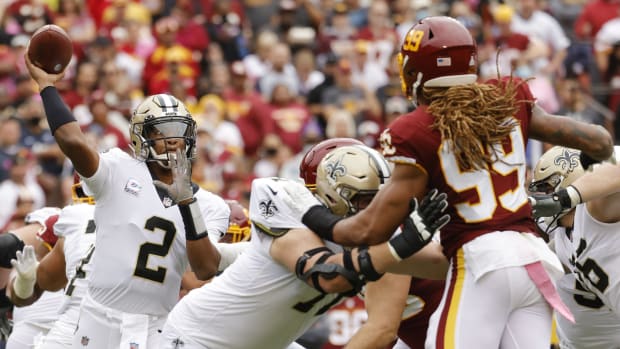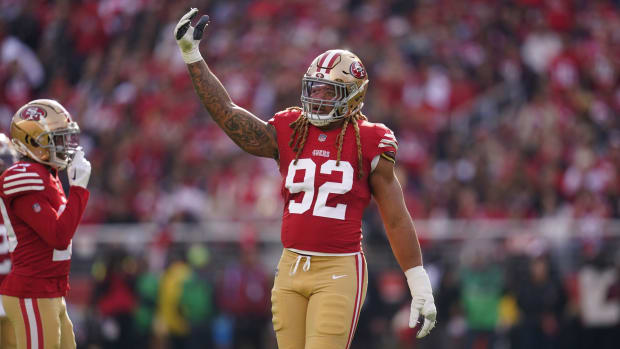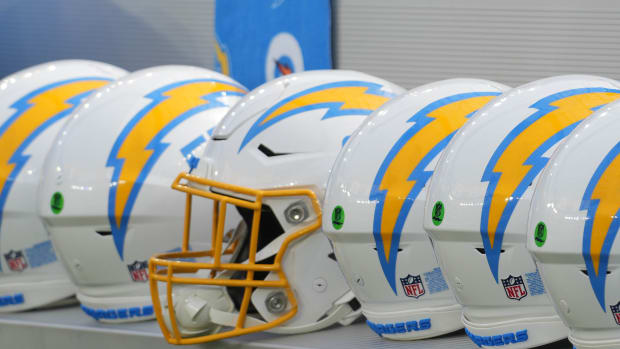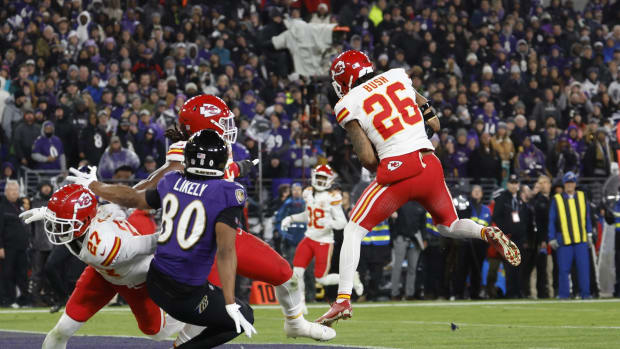
Open Season on Linemen
Ian Williams was lost for the season, depriving the 49ers of a valuable key on the defensive line.
It was on display for the entire nation to see. One of the biggest continued injustices in the NFL.
With eight minutes left in the first quarter of the Seahawks’ victory over the 49ers, Seattle ran a toss sweep to the left with Marshawn Lynch for two yards. On the interior, 49ers third-year nose tackle Ian Williams, playing on the right shoulder of center Max Unger, started to flow to his right to defend the run. Out of Williams' view, Seahawks right guard J.R. Sweezy dove at Williams’ left knee and continued to roll in his legs. Williams’ left ankle was broken, and he needed season-ending surgery.
Giants defensive tackle Cullen Jenkins, a 10-year veteran who also played with the Packers and Eagles, was watching the game at home. And he, once again, became enraged.
“I think just think it's messed up,” Jenkins told TheMMQB.com. “You've got a guy out there busting his butt trying to play and do stuff the way he's told. You're in the NFL, if you're an offensive lineman and you can't block someone, then you shouldn't be in the NFL. Why do you need to cut somebody from the side or take a shot like that? And when people are getting hurt and it's their livelihoods that are in jeopardy just because someone wants to take an easy block … I don't think that's right. It's out of hand and out of control. I don't understand why those type of things are ignored while we go with everything else to protect other players.”
Every other position on the field seems to be enjoying increased protection under the rules—don’t even think about breathing on a quarterback while he’s in the act of throwing or just after—except for defensive linemen. The Williams injury comes about a month after Vikings defensive tackle Kevin Williams (no relation) was chasing a play, watching the ball, when 49ers guard Joe Looney put his helmet right on the knee of Williams. Luckily Williams avoided a major injury. He called the block “dirty.” In the NFL rulebook, it was called legal.
Might as well declare it open season on NFL defensive linemen.
More Week 3
Peter King has everything you need to watch in Week 3, including the spotlight shining on a new starter in Denver.
Meanwhile, Andy Benoit picks all of Week 3's matchups.
“Yeah, it does feel like that,” Jenkins said. “I try to tell people we're not allowed to hit the quarterbacks low when it's our job to tackle the quarterbacks. So we have to try to bring this person down, but if he's in the pocket there you can't hit him low. Whereas as offensive linemen, it's not their job to try to tackle us, but they can hit us low or do whatever.”
The NFL looked into eliminating low in-line blocks in the offseason, but decided against it. The league said a players panel and coaches deemed a rule wasn’t needed.
“We did put a proposal in with respect to peel back inside the tackle box because we saw some plays that we really thought should be eliminated,” said Falcons president Rick McKay, the competition committee chairman. “We brought active and retired players in and talked low blocks from start to finish. They were all very consistent, ‘We can play the block. We can feel it coming. It’s not a concern.’ We went through it from start to finish with them because we had put out in the survey the idea that the chop block was under consideration and I think the players and the coaches—defensive line and offensive line coaches—convinced us otherwise.
“Low blocks and cut blocking has always been a necessity based on size. It is that ability to equalize. Whether it’s the big man on the little man in space, or whether it’s the little man on the big man when he is in close quarters. That has always been a method that’s been used.”
But does that need to continue? It’s hard to think of a reason why low blocks head up—like a running back taking out a blitzing linebacker—can’t continue, while blocks from the side are eliminated. That would also likely cut down on injuries to offensive linemen that come as a result of other linemen falling on the backs of legs in the tackle box.
You're in the NFL, if you're an offensive lineman and you can't block someone, then you shouldn't be in the NFL.
All injuries put a player’s career in danger. Fortunately, Ian Williams worked himself from an undrafted free agent to earn a two-year extension this offseason. Can you imagine if this injury happened while he was still working for the minimum? Still, Williams is far from set for life with his three-year, $3.76 million contract. What most don’t understand is that lower body injuries put a lineman’s career at risk—more than any other type of injury.
“If you have no lower body, you can't even play,” said Jenkins, an undrafted player himself who has been nicked up from time to time and saw his play suffer. “You have a 300-plus pound guy in front of you. You have to take on one, two guys at a time. If you don't have a base, if you're not able to have that strength to hold up the line, then you're no good. They'll just find someone else.”
If the NFL can put provisions in to protect a quarterback from even being tackled low, there’s no reason why similar protections can’t be afforded to defensive linemen. It’s time to make blocks legal only from above the knee on up. The NFL should be in the business of protecting the livelihood of all its players, not just those that put up fantasy statistics.
First ...
The Podcast
Julius Thomas, Brian Cushing and Cameron Wake stop by to talk with Peter King this week.
As Patriots tight end Rob Gronkowski nears a return after offseason back surgery, I hope he’s getting good advice. He is one of the league’s best players and, if healthy, he could go down as the best all-around tight end to play the game. Gronkowski is that good. He is still just 24 years old, with most of his career in front of him. But after two surgeries in four years, his back is a ticking time bomb if not fully healed. It’s why several teams took him off the draft board in 2010—even before the second procedure. I’m always leery about the medical decisions made on a player’s return to action, and that’s not specific to the Patriots. There’s too much conflict of interest. The team wants the player back (the Patriots are in desperate need of even viable targets), and a player always wants to play—especially someone like Gronkowski—so there aren’t many checks and balances. Already from Gronkowski we’ve seen him “play”—he was that compromised—on a badly injured ankle in the Super Bowl, and re-break his arm last season.
I don’t have a whole lot of confidence Gronkowski’s family would hold him back if he wasn’t quite ready; his father and brothers were all athletes. Agent Drew Rosenhaus has a very good relationship with Bill Belichick, and likes it that way. And Patriots team doctor Thomas Gill, who was not retained by the Red Sox after the 2011 season, recently had a grievance filed against him (and later withdrawn) by the NFLPA. ESPNBoston.com reported the union found evidence that may show Gill did not act in the best interest of former defensive tackle Jonathan Fanene (though it can’t be discounted that the grievance was just a recourse for the Patriots going after Fanene’s signing bonus). My question is this: who’s definitely looking out for Gronkowski’s best interest? That question is why I’m a proponent of players being handled by independent doctors, who solely decide when a player can return. Doubt that will ever happen, but it would be nice to have total confidence Gronkowski is receiving the best objective advice possible, because his long-term health is more important than this season.
... And 10
Cam Newton's struggles with a quick release led to him getting dropped for six sacks by the Bills.
1. Entering his third season, everyone knew Panthers quarterback Cam Newton was entering a critical stage in his career. And so far he’s not rising to the challenge, and not much has to do with the gameplans of coordinator Mike Shula. Newton still has flashes to brilliance—his touchdown throw to Greg Olsen against Buffalo was a beauty—but he has not improved his consistency, especially on third down. Last season he had a pedestrian 75.3 rating and 50.4 completion percentage. So far this year he’s at 77.4 and 60 percent. And four of the six sacks he took against the Bills came when he failed to get rid of the ball. Newton’s just not seeing the game clearly from the pocket. When he’s not staring down receivers, he’s holding onto the ball way too long—despite having open receivers. It’s obvious he’s lagging in the pre-snap phase. In other words, he doesn’t have conviction about where to go with the ball based on the defense before the snap. But Newton’s not a lost cause. He’s very close to getting it righted, if he can speed things up and see the game a little more clearly from the pocket. It wouldn’t hurt if Shula and coach Ron Rivera were a little more aggressive, however. Newton is seventh in the league with a 108.1 rating on first down. He’s 28th on second, and 20th on third. And calling nine straight runs before the final field goal against the Bills, and not even attempting a game-winning touchdown, is flat-out playing scared.
It's Complicated
Who won the Trent Richardson deal? Peter King says the Colts got the better of the swap, while Robert Klemko defends the Browns.
2.
I side with the Browns in the Trent Richardson trade simply for the fact that I don’t value running backs in today’s NFL. Here are the top running backs on previous Super Bowl winners (round drafted): Ray Rice (second), Ahmad Bradshaw (seventh) and Brandon Jacobs (fourth), James Starks (sixth), Pierre Thomas (undrafted) and Mike Bell (undrafted) and Willie Parker (undrafted). The lesson here, as always, is it doesn’t matter if you have Adrian Peterson, you’re not winning anything in this league without a top quarterback, so why not put all available resources into finding that quarterback? That seems like the Browns’ thinking. Mix in the fact that Richardson has a troublesome injury history as a physical back, and that he’s not the type of dynamic back that will make a line better than it is, and it’s hard to disagree with the trade. And I don’t want to hear anything about the “Browns gave up on the season.” They had/have no chance to win the Super Bowl this year. You know that, I know it and they know it. So get on with the rebuild.
3. For the Colts, this trade reeks of a fantasy football deal and the fanboy influence of owner Jim Irsay, who was trumpeting this trade all over his Twitter account. I have a lot of respect for general manager Ryan Grigson and the job he’s done so far (though to be fair, Andrew Luck would make a lot of GMs looks smart), especially in the draft. But there’s a fine line between building a consistent contender, and misjudging how good your roster really is and misappropriating resources to “put it over the top.” Combine being active on the free-agent market (guard Donald Thomas, who had injury issues previously in his career, is already on IR two games into his $14 million contract) and this deal, and the Colts have a lot riding in the short term. At the moment, they appear weak on the offensive line, rushing the passer, in the secondary, and the season-ending injury to outstanding all-round tight end Dwayne Allen is huge. Not sure how Richardson helps those issues much. Of course, maybe Grigson feels emboldened because Luck is so good.
It's Brian Hoyer's team in Cleveland, for now and possibly the forseeable future.
4. Speaking of the Browns, I wasn’t surprised to hear that Brian Hoyer got the nod at quarterback over Jason Campbell with Brandon Weeden injured—and Weeden isn’t assured of getting his job back. When I visited Browns mini-camp in June, I came away thinking that Hoyer would be heard from in the quarterback competition, and was the best on the roster. The language of Norv Turner’s offense is completely different than what Hoyer has been in previously (mostly with the Patriots), so it was going to take him a little time. Hoyer has the best arm, release, instincts and leadership skills of the group. He’s not a franchise quarterback, but you want him in a competitive situation like the Browns had. What you’ll see from Hoyer is a good arm to all parts of the field, a willingness to try to fit the ball into a few spots that he shouldn’t, and his issue back to college at Michigan State has always been inconsistent accuracy. He’s improved slowly but steadily in that area since entering the league in 2009.
5. Most of the focus has been on the Ravens’ lack of productive receiving targets, but what has been overlooked is the subpar play of the offensive line. One of the big keys to the march to the Super Bowl was when Bryant McKinnie was inserted at left tackle, Michael Oher went to right tackle, and then-rookie Kelechi Osemele moved to left guard. Quarterback Joe Flacco was barely breathed on in the playoffs as the line was tremendous. The biggest difference this season is Gino Gradkowksi, a fourth-round pick in 2012, being tapped at center following Matt Birk’s retirement. Gradkowski has been the weak link so far. He is not strong at the point of attack in the pass or the run game. It appears that his center of gravity is higher than you’d like at the position, which leads to him being pushed around. He also doesn’t sustain blocks well. If the center of the line is compromised, that’s tough to overcome for the unit. But Gradkowski hasn’t been alone in his struggle. Osemele, another sophomore, hasn’t been much better and McKinnie also hasn’t been sharp. Oher (up and down) and right guard Marshal Yanda (outstanding) have been their usual selves. It doesn’t get any easier for the Ravens offensive line with the Texans up next.
6. Keep an eye on how well the Packers’ pass protection holds up in their showdown with the Bengals’ vaunted defensive line. While left tackle David Bakhtiari (rookie) and Don Barclay (second year) have held up reasonably well so far at left and right tackle, respectively, the injury situation at running back could be an issue. Fullback John Kuhn, the team’s best pass-blocking back, is doubtful, and Eddie Lacy is questionable. That leaves just two running backs on the roster at the moment: James Starks and rookie Johnathan Franklin. Starks has shown vast improvement in pass blocking; it will be curious to see how much confidence they show in him. Franklin struggled, as most rookies do, during the preseason. Of course, working in the Packers’ favor is the fact that Rodgers is deadly with his arm and legs against the blitz. So maybe Bengals defensive coordinator Mike Zimmer will hang back.
Fantasy Island
Looking for advice to set your lineups this week? Alessandro Miglio and Eric Edholm have answers.
7.
It was only a matter of time before Buccaneers fans became disgruntled with the conservative game coaching of Greg Schiano. Most saw how he turned around Rutgers, and automatically considered assumed Schiano was a good coach. He’s a good manager and instructor, but his game coaching left some to be desired. Time after time the Scarlet Knights came up short of a conference title—and it wasn’t all about a talent deficit. The deeper it gets into the game, the more Schiano opts not to lose. The Bucs ran the ball six straight times before settling for a 47-yard field goal with 1:10 left on Sunday against the Saints. Ryan Lindell missed, and the Saints drove down to win the game.
8. One of the biggest remaining questions from Week 2 is why, one week after offensive coordinator Greg Roman devised a brilliant gameplan to get Anquan Boldin open with bunch formations and motion against the Packers, the 49ers did none of that against the Seahawks? The 49ers receivers were almost totally static against the Seahawks, which allowed their physical cornerbacks to easily match up. Boldin is a good player, but against a physical cornerback like Richard Sherman, he’s going to have a hard time getting open with his lack of speed. Perhaps the 49ers didn’t use motion to cut down on the possibility of mental errors and penalties in raucous CenturyLink Field. If that was the case, that makes the Seahawks’ home-field advantage even greater.
9. One of the Falcons’ biggest issues entering this season has been their inability to finish off victories in some of their biggest games, including the NFC Championship Game last year in which the Falcons led the 49ers 24-14 at halftime. An ineffective run game was the culprit, so Steven Jackson was signed. He was injured early against the Rams last Sunday, but that’s still no excuse why the Falcons, who led 24-3 at halftime, finished with 16 rushing plays and 45 pass dropbacks, including a stretch of 13 passes in 14 plays in the third and fourth quarters. They nearly blew that game, as the Rams inched to within 24-17 in the fourth quarter. Backups Jason Snelling and Jacquizz Rodgers are two very good backups. The Falcons have to find a way to run the ball better.
10.







































